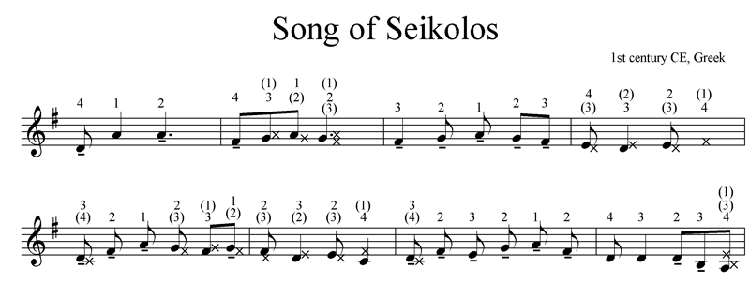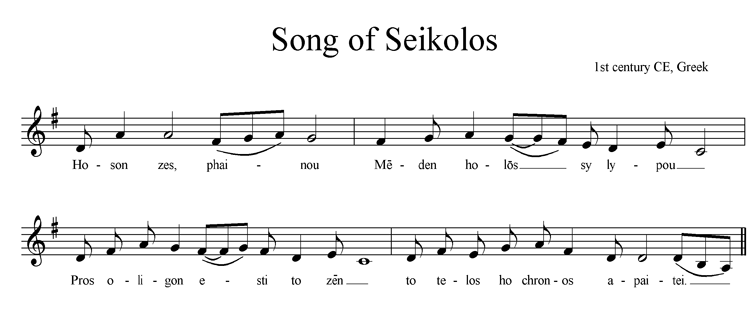The Song of Seikilos
Originally published in the Bulletin of the Hisorical Harp Society December 2010
The Song of Seikilos was inscribed on a tombstone in the 1st century of the common era. It includes both words and a melody, and stands as the oldest complete musical composition that has survived anywhere in the world.
The musical notation is early Greek, of course, and is not read by most musicians today (including me). I primarily depended upon a representation of the song in modern notation, which my friend Sten Maulsby shared with me and which is easily found on the Internet through a search for either of two common spellings, Seikilos or Seikolos. The melody is invariably represented with a 6/8 time signature.
While you live, shine!
Don’t suffer anything at all.
Life exists but a short while,
And time demands its toll.
Greek music notation includes separate signs for note duration, rests, articulation, and ligation (slurring patterns), with letters representing pitch. After studying a transcription of the Greek music from the tombstone, I felt that the drive implied by the modern time signature was not in keeping with the durational and ligation signs of the original; therefore I eliminated the time signature.
The first version (see below) has the rhythm of the standard transcription of the song. I have notated the fingering, damps, and rings for wire-strung harp. (NB, x-headed notes with parenthetical finger numbers represent notes to be damped and which finger to damp them with. The tenuto sign indicates notes to be allowed to ring.) This is of course not the only way to play and damp this melody, and for me it changes now and then. Enjoy playing with your own ideas; please don’t stay limited to mine.

While I am no Greek scholar, I am a musician. Taking into account the feelings inspired by the words, the impression of the Greek notation, and the situation of the music on a tombstone, I choose to perform it in a more relaxed manner of long notes, short notes, and an occasional triplet. This is how I have tried to represent it in the second version below, where the shortcomings of rhythmic notation are overcome by the use of free rhythm. In this next version of the song, barlines simply mark the divisions between lines of text. Places of slight pausing, as well as the areas of quick acceleration, are impossible to represent.

No accompaniment is included other than the harmonies left to ring. I like to play the melody first with either my left or right hand alone and then both hands together. Played two octaves apart, if your harp is big enough, produces an interesting effect.
As you play the piece, think of the words of the epitaph, written by Seikilos for engraving upon his beloved wife’s tombstone. Relax and don’t worry about time at all.
Hoson zis phenou
miden holos su lupou
pros oligon esti to zin
to telos ho chronos apeti
Resources:
Thomas J. Mathiesen. Greece: Ancient: Rhythm notation.
The New Grove Dictionary of Music and Musicians Second Edition (Oxford University Press, 2001) Vol. X p. 342.
A transcription from the tombstone of the Greek notation of The Song of Seikilos. Accessed 16 November 2010.
For a printout of the music presented on this page, you may download this pdf of the Song of Seikilos.